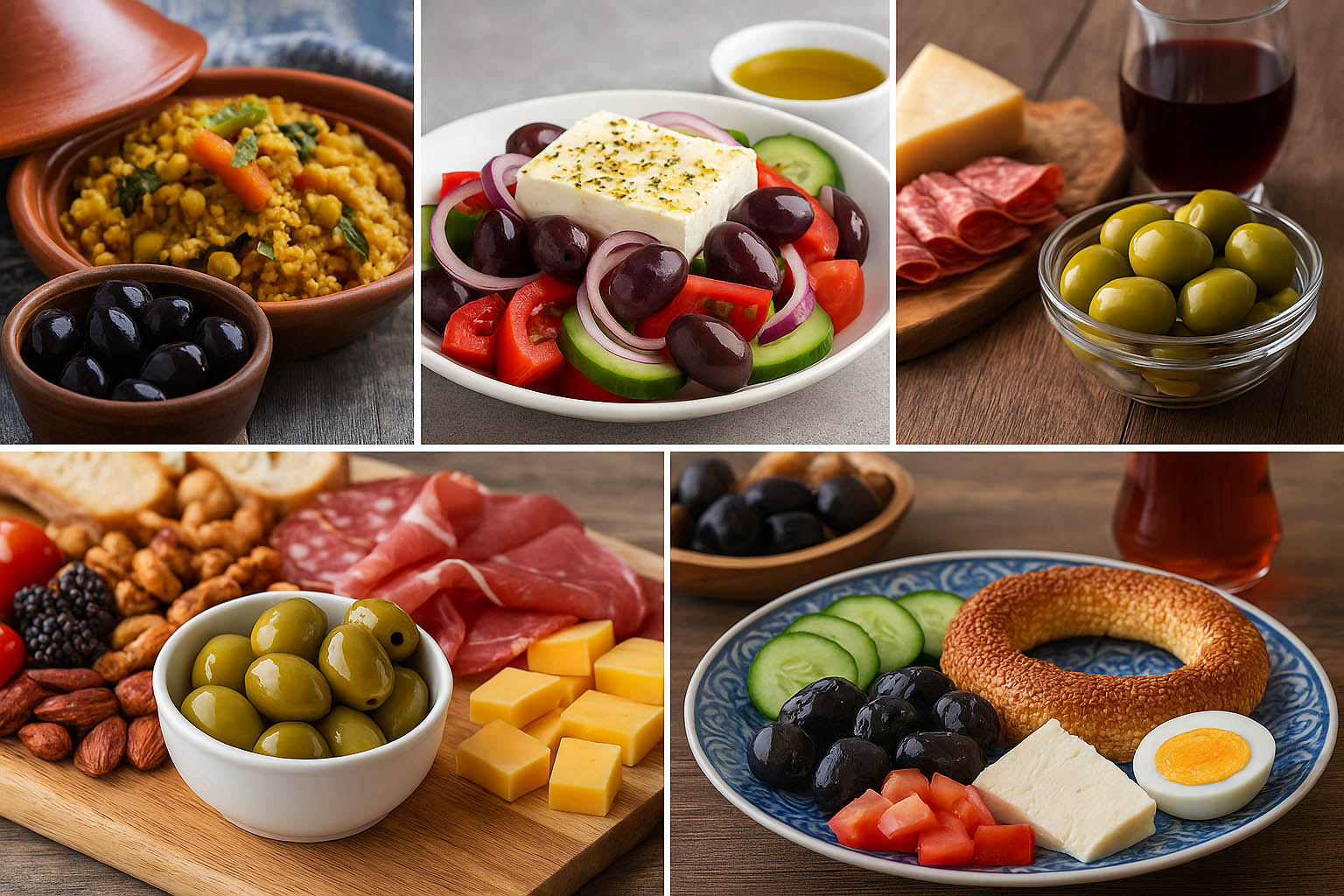Olives are one of the world’s oldest and most versatile foods. From Moroccan souks to California supermarkets, this fruit of the olive tree has captivated palates and traditions across continents. Around the globe, olives are consumed in a variety of ways—as appetizers, key ingredients, or cultural symbols.
In this article, we take you on a journey through several countries and cultures to discover how olives are enjoyed outside of Spain, and how they are integrated into their cuisines, rituals, marketplaces, and ways of life. We’ll also explore how Aceitunas Torrent has positioned this product as a global food without losing its Andalusian essence.
Morocco: Olives at the Heart of the Table
In Morocco, olives are omnipresent—from breakfast to dinner, they are consumed daily and are a central part of the national culinary identity.
Everyday consumption
- Traditional Moroccan breakfast: bread, olive oil, and a handful of natural-cured black or purple olives.
- Tajines and couscous: often cooked with green olives and preserved lemon for flavor and saltiness.
- Cold salads: like taktouka, with tomatoes, peppers, and green olives.
Seasoning styles
- Olives marinated with harissa, garlic, cilantro, lemon, and cumin.
- Widely sold in bulk at local markets with bold, aromatic marinades.
Morocco is one of the top per capita consumers of table olives. Spanish olives—especially the Hojiblanca variety—are widely appreciated for their taste and versatility.
Greece: Timeless Flavor and Mediterranean Soul
In Greece, olives are more than food—they’re symbols of wisdom, health, and victory since ancient times.
Culinary presence
- Kalamata olives: globally known for their dark purple color and fruity taste. Used in salads, breads, or enjoyed on their own.
- Traditional Greek salad: tomatoes, cucumber, red onion, feta cheese, oregano, and a generous portion of black olives.
- Olive bread (Eliopsomo): traditional loaves that incorporate olives into the dough.
Greek olive consumption is closely tied to the Mediterranean diet, where olives contribute healthy fats, texture, and flavor.
Turkey: Breakfast Always Includes Olives
In Turkey, olives are essential to kahvalti, the traditional Turkish breakfast.
Kahvalti: A daily ritual
- Multiple varieties are served: green, black, dry-cured or marinated.
- Accompanied by cheeses, cucumbers, tomatoes, jams, eggs, and simit (sesame bread).
- Turkish wrinkled black olives, dry-cured and intensely flavorful, are highly prized.
Preparation and serving
- Marinated with olive oil, thyme, and lemon.
- Presented in small bowls as part of a shared meal experience.
Spanish olives are well received in Turkey for their consistent size, texture, and quality.
Italy: Elegance and Regional Diversity
In Italy, olives are used in diverse ways depending on the region and variety. They’re essential to Italian aperitivo culture but also appear in cooked dishes, sauces, and spreads.
Culinary uses
- Italian tapenade (patè di olive): made with black olives, garlic, capers, and extra virgin olive oil.
- Olive ascolane: green olives stuffed with meat and deep-fried—an iconic dish from central Italy.
- Pasta alla puttanesca: with black olives, capers, garlic, and tomato sauce.
With wine
- Olives are a popular pairing with wine in bars and terraces.
- Often included in apericena spreads with cured meats and cheeses.
France: Gourmet Olive Accents
France has incorporated olives into its culinary culture, especially in the south where Mediterranean influences are strong.
Southern French cuisine
- Provençal tapenade: black olives, anchovies, and garlic blended into a spread for toasted bread.
- Tian Provençal: oven-roasted vegetable dish with olives.
- Pissaladière pizza: caramelized onions, anchovies, and black olives.
France is a major destination for Spanish olive exports due to strong demand for gourmet and health-conscious foods.
United States: From Pizza Topping to Wellness Trend
In the U.S., olive consumption has evolved—from being a pizza topping to a trending healthy and gourmet snack.
Changing habits
- Growing interest in additive-free, low-sodium products.
- Innovative formats: liquid-free pouches, stuffed olives with jalapeño, blue cheese, or roasted garlic.
- Featured in charcuterie boards, grazing tables, and brunch spreads.
In American cuisine
- Black olives in fast food salads and Tex-Mex dishes.
- Green olives remain a staple in cocktails like the classic Dry Martini.
Aceitunas Torrent meets U.S. market needs with products like The Coolives, designed for healthy on-the-go snacking.
Germany: Natural Flavor and Functional Nutrition
Germany values functional, clean-label foods, which has fueled a rise in olive consumption in recent years.
German consumer preferences
- Preference for natural, pitted olives in convenient packaging.
- High demand for organic and certified-origin products.
- Commonly consumed as snacks, in breakfasts, or in vegetarian dishes.
Aceitunas Torrent has seen increased interest in low-salt and sustainably certified olives in the German market.
Mexico: A Blend of Cultures and Bold Cuisine
In Mexico, olives play an important role in dishes with Spanish and Arab roots. They’re used in both traditional and modern cuisine.
Typical uses
- In bacalao a la vizcaína, with capers and olives.
- In rice dishes like arroz a la tumbada.
- In street food and snacks, such as torta de bacalao
Flavor profiles
- Whole olives with pits and spicy marinades (e.g., with jalapeño) are popular.
- Black olives are gaining ground in fast food and pizza toppings.
Mexico bridges Mediterranean tradition with Latin flavor—making it a key cultural and culinary market for olives.
A Global Product with Local Soul. Olives are universal, yet they maintain their local character in every culture. They adapt, transform, and bring something essential to every table: flavor, health, and a deep connection to the land.
At Aceitunas Torrent, we work every day to preserve the Andalusian roots of each olive while ensuring they resonate with global cuisines and consumer expectations. Because beyond the product, what we truly export is a Mediterranean lifestyle.
FREQUENTLY ASKED QUESTIONS ABOUT OLIVE CONSUMPTION AROUND THE WORLD
¿Las aceitunas españolas se consumen igual en todo el mundo?
No. Cada país tiene preferencias específicas en sabor, formato y uso culinario. Por eso se adaptan recetas, aliños y presentaciones según el mercado.
¿Qué variedades exporta más España?
Hojiblanca, Manzanilla, Gordal y Cacereña son las más demandadas internacionalmente por su versatilidad y calidad.
¿En qué tipo de comidas se usan más fuera de España?
Desde desayunos (Turquía) hasta snacks (EE. UU.) o platos principales (Marruecos), las aceitunas son increíblemente versátiles.
¿Cuál es el mercado más innovador en consumo?
EE.UU. lidera la innovación en formatos: snacks sin líquido, rellenos gourmet y packs para vending o e-commerce.
¿Qué valor tiene el origen andaluz fuera de España?
Mucho. Andalucía se asocia con autenticidad, tradición y calidad mediterránea. Es un sello de origen muy valorado.










